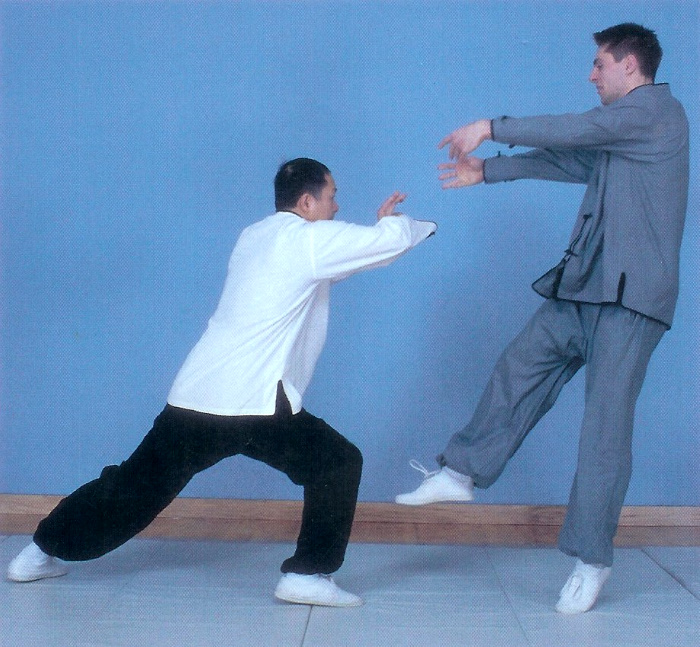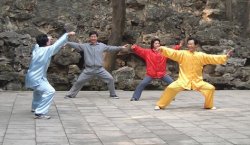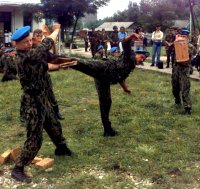A poem inspired by Billy Collins
Tag: kata
Ordosclan, The Grumpy Savant of rec.martial-arts

Long before the invention of the blog, and even before the creation of the World Wide Web, there was Usenet. The world’s first electronic social network was established in 1980, and martial artists have been arguing there ever since.
Back in the late 1990s, I started reading the rec.martial-arts newsgroup as most people do, with posts sorted by discussion topic. I soon discovered that, since 90% of the replies on any given topic were rubbish, it made more sense to sort by author instead. Although I abandoned rec-martial arts years ago, due to its low-signal-to-noise ratio, I can still remember the names of some of my favorite writers. At the top of that list, I place the mysterious Ordosclan, also known as Turiyan Gold.
I don’t know Ordosclan’s real name, or his training history. I don’t know how many of his posts were written under the influence of anti-psychotic medication, as his critics claimed. Perhaps not enough of them.

Ordosclan’s martial arts commentaries were sagacious and entertaining, sometimes cryptic and unfortunately brusque. In honor of Black Belt Mama’s Admired Martial Artists Month, I’d like to highlight a few:
In boxing, the boxer keeps his hands up on either side of his face for protection. Punches are thrown from this position. One hand goes out, the other stays by the face for protection.
Why does karate require that you throw a punch from the hip? What is gained by this?
The point of pulling the fists back is to open the chest. Doing so during stance changes makes it harder to use the arms for balance. It’s not for punching. Punches done from the hip are just a training exercise. The Japanese simply copied basic Shaolin from the Chinese. Some teachers try and read ridiculous theories into why something is the way it is: “It’s for qi,” “it’s for jing,” “It trains you to monkey elbow a guy that puts you in a bear hug from behind”, etc.If you start taking things out of MA that are not combat-relevant, you’re left with punches and kicks, knees and headbutts. The simple answer is: it’s not martially oriented. Its just a myth that Shaolin monks are/were “fighting” monks. That’s nonsense. And everyone knows it.
Tips for a Successful Martial Arts Demonstration
Last weekend, I attended the third annual World of Martial Arts demonstration in Seattle. The event featured local Karate, Hapkido, Iaido, Tai Chi, and other groups.
As in previous years, the show had some positive qualities, and a few negative ones. In the spirit of constructive criticism, I would like to offer some suggestions to participants in future demonstrations.
- Every spectator should have an unobstructed view of the action. Seating your audience in chairs where they cannot actually see the demonstration is obscene. If you are performing in a flat gymnasium or some other ad hoc arena, pay special attention to the seating arrangements.
Push Hands and Competition
Push hands is an accessible abstraction of fighting. Whereas mortal combat follows no pattern and honors no rules, the push hands exercise is relatively limited in scope. Push hands practice alone will not make a top fighter, nor is it intended to do so; it focuses on specific characteristics, such as sticking and following, in order to provide a consistent and effective learning environment.

Yang Jwing-Ming demonstrates Press (Ji)
Abstractions such as the fixed step tui shou exercise are often misused, by students who do not fully understand their context within the larger Tai Chi curriculum. These students shape the exercise into something more or less than it is intended to be, diminishing its relevance and benefits, and shortchanging themselves and their training partners.
What should the pushing hands drill include, and what should it exclude?
3 Ways to Make Tai Chi Form Practice More Interesting

Chen style Tai Chi Chuan practice
Attaining competency in Tai Chi Chuan requires hundreds of hours of correct form practice, and mastery requires thousands more. One impediment to sustained practice is a lack of interest: Tai Chi forms are too boring to perform daily.
Perseverance in the face of boredom builds character; however, feelings of boredom may be a sign that your learning has stalled. To keep your practice fresh, productive and fun, try performing these variations on your standard Tai Chi forms.
